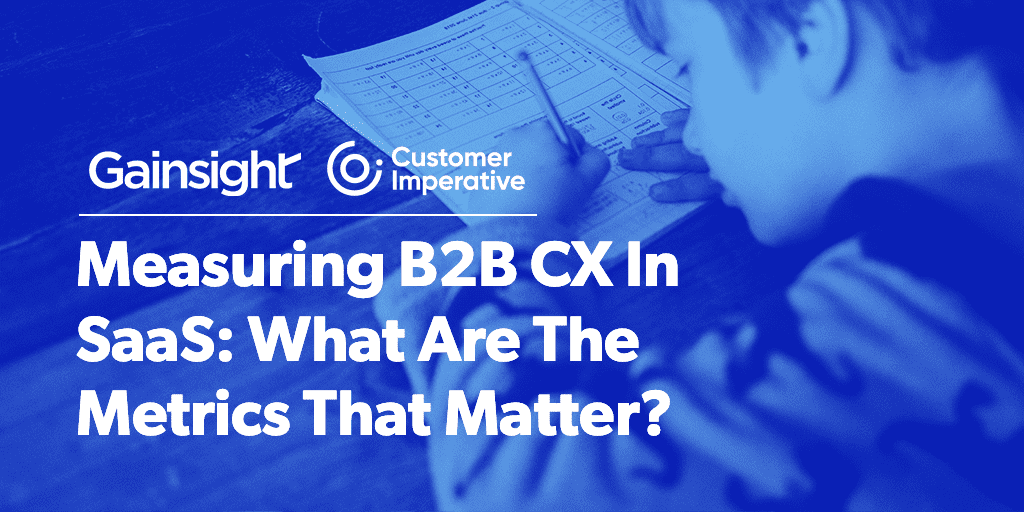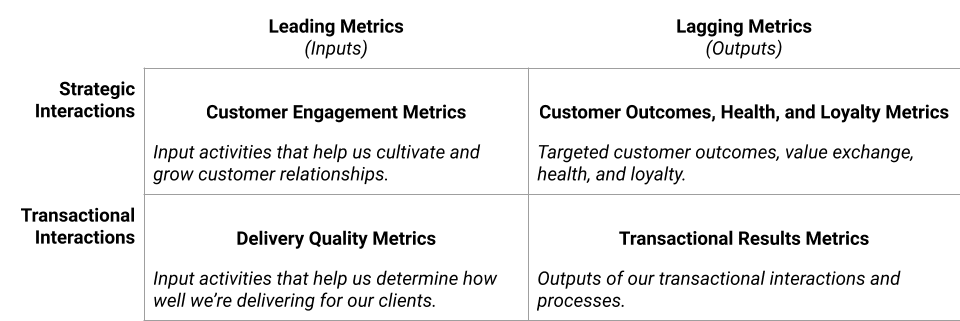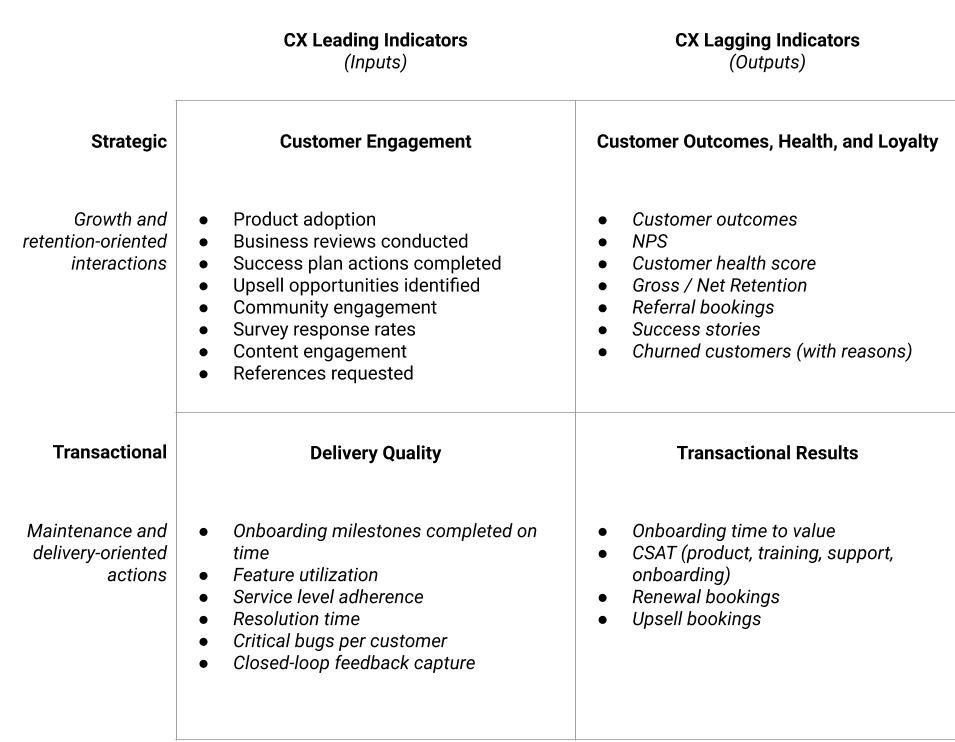According to a B2B Marketing survey, two-thirds of marketers are making CX a priority in the next twelve months.
More than a quarter of those surveyed are prioritizing CX before the year-end, largely because CX is set to become the most influential factor in customers’ minds as they sort through their options in saturated markets.
Of the B2B companies that are fine-tuning their CX strategy, they are said to have strong revenue growth and ROI, reporting more than a 2x return on their investment.
The bottom line is clear: measuring and improving the customer experience is not only good for customers, it’s good for business. A focus on CX creates a competitive advantage that drives customer retention, revenue expansion and enterprise valuation over time.
B2B CX: Beyond customer surveys
The beautiful thing about B2B SaaS companies is that we have multiple sources of CX data at our fingertips. Consider the possibilities to leverage data from learning management systems, support cases, CRM, the customer success platform, marketing automation tools, content management systems, and online communities. So much data, so little time!
We can often use these data sets to infer the customer experience by proxy. This is a massive benefit for SaaS companies because we don’t have to rely solely on surveying our customers to gain a view into CX performance.
Take the support response times, for example. With data from our case management system (Zendesk, Service Cloud, etc) we can easily measure whether or not we are meeting customer service service level agreements (SLAs). Knowing whether we are meeting our service delivery standards is one data point of many that we can use to understand our CX performance.
This is a simple example, but there are many more interactions we can monitor. Consider the following:
- Critical bugs or outages experienced by customers
- Customer onboarding and time to value
- Key feature utilization rates
- Open support cases greater than n days old
- Closed-loop follow up percentage (after negative feedback)
It is possible to track internal processes related to onboarding, support, product and customer success that addresses all of these areas.
Capturing customer sentiment is still important
While access to internal data is an advantage it doesn’t provide enough information to tell the whole story. We need to add “outside-in” perspective, captured directly from our customers. There are two primary tools we can use to collect customer sentiment throughout their journey: Net Promoter (NPS) and Customer Satisfaction (CSAT) surveys.
NPS and CSAT are two very different, but complementary methods of gathering customer insights. NPS measures a customer’s overall satisfaction with and loyalty to the company. It is a simple feedback mechanism that asks, “How likely are you to recommend [company] to a friend or colleague?”
NPS respondents provide a 0-10 rating with zero being the least likely and 10 being the most likely to recommend. Detractors (0-6s) are subtracted from the total number of promoters (9s and 10s) to give a net promoter score.
Because of its simplicity, NPS is known to receive a higher response rates from survey recipients. In addition to providing a score we can use to track and measure brand loyalty, NPS also creates a fantastic engagement opportunity. We encourage companies to “close the loop” with every respondent, e.g. a call to dig deeper into their issues or an advocacy request respective to their response.
In contrast, CSAT measures customer sentiment related to a specific type of interaction at the point of delivery. These surveys are normally sent after a training session is conducted, upon completion of onboarding, or closure of a support case.
CSAT is based on a five point rating system ranging from “Very Dissatisfied (1)” to “Very Satisfied (5).” The percentage of respondents providing a “Satisfied (4)” or “Very satisfied (5)” response make up the CSAT score for that interaction.
A framework for measuring CX
Hopefully you’ve bought into the fact that a focus on CX will create value for your business, and that CX can be measured using both internal and external data. Now let’s dive into more detail on which measures are most effective for illustrating CX and its impact on your business.
We’ll start with a framework. The 2×2 matrix below outlines four types of CX metrics. The types are based on whether they are leading or lagging indicators and whether they measure strategic or transactional customer interactions.
Lagging metrics represent outcomes and tell us what the customer experience was in the past. Leading metrics help us predict future outcomes.
It’s important to have leading metrics associated with each lagging metric that we care about. Attempting to manage on lagging metrics alone—such as NPS—is akin to trying to lose weight without paying attention to calorie intake or exercise.
Interactions are the touch points we have with customers. Strategic interactions help us move customer relationships forward and grow them while transactional interactions are operational in nature, e.g. onboarding, training, handling support cases, daily product usage.
Let’s unpack each type of B2B CX measurement:
Customer Outcomes, Health and Loyalty Metrics
This category contains metrics that indicate the strategic value and risk of the customer base, and contains sentiment, health and loyalty metrics. Customer outcomes, referenceability, NPS, retention and upsell rates fall into this category.
Perhaps an obvious statement is that customers who achieve tangible business results often have a longer lifetime value. That said, customer outcomes can be the most nebulous of metrics to calculate. They are unique to the market, value proposition, product and service delivery model of every SaaS company.
That said, it’s critical to find a formulaic approach to measure customer value. Often companies will use an adoption-oriented metrics as a proxy for value. For instance, an HR technology company whose product helps streamline the hiring process might measure the number of applicants and time to fill positions correlated with overall hiring and retention cost goals.
Customer Engagement Metrics
Customer engagement metrics measure strategic interactions with our customers that lead to retention, growth and loyalty. Strategic interactions usually occur outside of day to day product usage. Business reviews, reference requests, upsell opportunity identification and customer community engagement interactions all fall into this category. These activities focus on validating value, deepening the commercial relationship, engagement in customer community and advocacy.
Delivery Quality Metrics
As a B2B SaaS company, there are some activities we must do well but don’t provide much upside lift in customer experience. I think of these as “price of entry” processes, and they include product availability/uptime, service delivery, and customer support responsiveness.
Customers expect these day-to-day interactions to be reliable and dependable. For this reason, strong transactional delivery alone doesn’t translate into customer growth and retention. On the flip side, failure to deliver in any of these areas can cause significant risk to the business. Revenue, retention and strategic expansion opportunities are more difficult to maintain if we’re not “blocking and tackling” for our customers so it’s critical to pay to pay attention to these tactical interactions.
Transactional Results Metrics
Finally, transactional results help us understand tactical outcomes related to tactical customer delivery interactions.
Putting it all together
When you put it all together, you get an array of metrics that offer a balanced perspective on the customer experience. Every SaaS business is unique, but companies should be looking at a mix of these metrics across their customer journey.
Here are a few rules of thumb to follow when establishing your CX measurement practice and choosing metrics for your dashboard:
- Start small. Start with 8-12 metrics that hit on the key interactions and customer outcomes you’re looking for. Prioritize delivery quality and customer engagement metrics and validate their correlation to customer and business outcomes.
- Set baselines and establish targets. Especially if embarking on CX measurement for the first time, it’s important to understand a baseline value for each metric. Once established you can determine the appropriate target for each metric.
- Plan initiatives based on deviation from targets. Remember what we are doing all this work for: to drive improvement in the customer experience and business outcomes for our customers and our own organization. Customer experience management in B2B SaaS is a continual process. A formal measurement process will make initiative planning become data-driven process.
- Segment customers. Many SaaS providers serve a wide variety of customers ranging from small corporate to large enterprise. CX issues can easily be hidden in the data. If possible, break down metrics by having a dashboard at the customer segment to develop a deeper understanding. Most often this will align with go to market segments.
- Track over time. We see far too many dashboards that represent one static point in time. Unless we plot these metrics over time and examine trends it’s difficult to understand whether we’re on a positive or negative path in a given area. It’s also impossible to spot correlation between metrics.
- Use a mix of internal and external data sources to cross compare what our internal process data indicates versus what customers are actually feeling.
- Finally, get executive buy-in. CX is not something that any one department alone can control. A recent Accenture survey revealed that although 90% of B2B executives reported that CX was crucial to their business, only 72% of them had actual influence over CX initiatives.
Consider crafting a CX strategy statement defining how you intend to use CX as a competitive advantage and incorporate it into your annual goals and planning. CX takes a village, so ensure your strategy reflects the needs and goals of every department, from Customer Success to Sales, Product and Engineering.
Despite its importance of customer experience to the health of every B2B SaaS business, virtually all SaaS companies are still building CX discipline. Creating a focus on CX within your organization now can create a competitive advantage in the marketplace that will be difficult to mimic.
Read the rest of our CX series
Customer Imperative provides accelerator workshops that prepare B2B SaaS customer success teams to deploy Gainsight.



